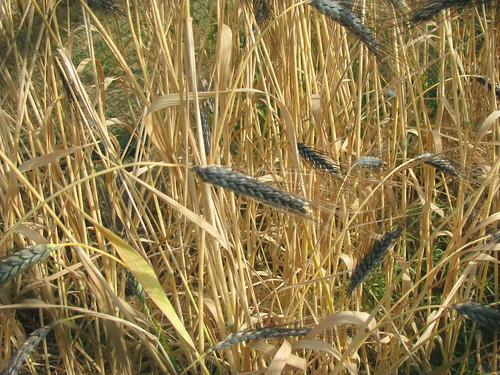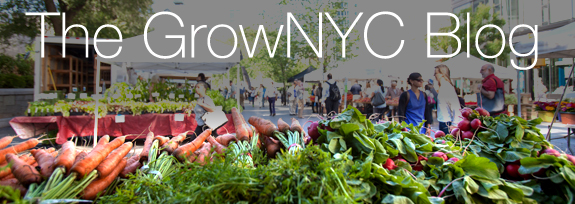Move over Quinoa...

Another ancient grain is roaring back to life in the city’s Greenmarkets and restaurants -- and this one is grown by farmers right here in our very own state. Emmer, the sweet, robust grain that adds dreamy texture to any soup or salad, grinds into a fine flour used in pasta and bread, and makes an incredible pilaf or hot cereal all on its own, is taking its well-deserved place in the spotlight. In just the latest example, Gramercy Tavern Executive Chef Michael Anthony is featuring emmer grown by Cayuga Pure Organics, a farm located in the Finger Lakes region, in the soup he created for Hale and Hearty and being served in its restaurants this week (12/10/12-12/16/12).
Emmer, called farro in Italy, is among the oldest forms of wheat. Its cultivation dates back 10,000 years to ancient Egypt and Israel, where it was used to make matzoh as well as leavened bread, pasta and beer. It gradually fell out of favor because emmer seed has to go through an extra step after it’s threshed called dehulling, which removes the seed from its hull, or husk. It was replaced by wheats that broke free from their hulls in the threshing process, like modern bread wheat and durum wheat (commonly used for pasta). Thankfully farmers throughout Europe, Turkey, and Ethiopia still appreciate emmer’s special qualities and grow it aplenty.
The hardy crop hit American soil in the late 19th century, when German farmers migrating from Russia planted it in settlements across the northern plains of North Dakota and Montana. The USDA quickly spotted its merits: Not only was it extraordinarily high in protein and fiber content, but it proved remarkably tolerant to extreme weather, assuring a harvest even when the wheat crops failed.
Emmer found its way to this region in 2009, when organic farmers in North Dakota who were willing to share this potentially high-value crop relatively new to the U.S. -- which they alone possessed – sent a seed shipment to organic growers in New York and Pennsylvania. The momentous hand-over was part of a USDA-funded collaboration among farmers, crop scientists and sustainable agriculture advocates (Greenmarket) intent on introducing farmers and consumers to this new-old grain.
The group also hopes to clear the confusion people have between emmer, spelt and farro -- which has long frustrated farmers and researchers. In a rare show of annoyance, a 1911 USDA report cited the necessity “to protest strongly against the use of incorrect names for emmer.” Now that chefs in our region have their very own source of home-grown emmer -- no need to import farro from Italy anymore! -- they are only beginning to discover the subtle differences between this hardy grain from the plains, and the crop of the same species that took another path to the Mediterranean, acclimating to Italian conditions over the years.
Cayuga Pure Organics began selling emmer at Greenmarket, where it has been embraced by regional grain enthusiasts, including Chef Anthony. Chef Patti Jackson, late of I Trulli, made a memorable emmer pasta at a regional grains tasting in 2010 that folks are still raving about. With its rise in popularity, you can expect emmer to pop up more and more on menus around the city. You’ll surely see it in a range of forms, whether the whole grain, a bag of flour, a loaf of bread, fresh pasta or flatbreads. At some point in the not-too-distant future you might even be toasting an emmer beer or savoring an emmer whiskey cocktail.
Recent Posts
- GrowNYC Publishes 2023 Impact Report
- 2024 Seasonal Greenmarkets and Farmstands Opening!
- GrowNYC's 2024 Plant Sale
- Use Pandemic EBT (P-EBT) with GrowNYC
- The 2024 Health Bucks are now available!
- Sign Our Petition: Save Community Composting
- 2023 Holiday Schedule - Greenmarkets, Farmstands, Food Scrap and Clothing Collections
- Deck the Halls - 2023 Greenmarket Gift Guide & Christmas Trees + Holiday Wreaths at Greenmarkets
- GrowNYC Weather & Site Closures
- Thanksgiving Week Schedule 2023 - Greenmarkets, Farmstands, Compost
Tags
- Grains
- compost
- recycle
- recycling
- greenmarket
- kids
- union square
- swap
- youthmarket
- grow to learn
- learn it grow it eat it
- reuse
Archives
- April 2024 (1)
- March 2024 (2)
- February 2024 (1)
- December 2023 (1)
- November 2023 (3)
- October 2023 (5)
- May 2023 (1)
- April 2023 (2)
- December 2022 (1)
- November 2022 (3)
- September 2022 (1)
- June 2022 (1)
- April 2022 (2)
- March 2022 (2)
- December 2021 (2)
- November 2021 (1)
- October 2021 (3)
- September 2021 (3)
- August 2021 (2)
- June 2021 (3)
- May 2021 (1)
- April 2021 (1)
- March 2021 (1)
- January 2021 (8)
- December 2020 (2)
- October 2020 (3)
- July 2020 (1)
- June 2020 (2)
- March 2020 (6)
- February 2020 (3)
- January 2020 (2)
- December 2019 (2)
- November 2019 (1)
- October 2019 (1)
- September 2019 (7)
- July 2019 (4)
- June 2019 (1)
- May 2019 (1)
- April 2019 (3)
- March 2019 (4)
- February 2019 (3)
- January 2019 (3)
- November 2018 (3)
- October 2018 (3)
- September 2018 (1)
- August 2018 (2)
- July 2018 (4)
- June 2018 (5)
- May 2018 (1)
- April 2018 (1)
- February 2018 (3)
- December 2017 (2)
- November 2017 (3)
- October 2017 (7)
- September 2017 (4)
- August 2017 (3)
- July 2017 (1)
- June 2017 (2)
- May 2017 (4)
- April 2017 (1)
- March 2017 (2)
- February 2017 (2)
- January 2017 (3)
- November 2016 (1)
- August 2016 (1)
- July 2016 (4)
- April 2016 (2)
- March 2016 (4)
- February 2016 (2)
- January 2016 (1)
- December 2015 (4)
- November 2015 (2)
- October 2015 (2)
- September 2015 (4)
- August 2015 (2)
- July 2015 (2)
- June 2015 (3)
- May 2015 (2)
- April 2015 (2)
- March 2015 (1)
- February 2015 (2)
- January 2015 (2)
- December 2014 (3)
- November 2014 (5)
- October 2014 (3)
- September 2014 (3)
- August 2014 (3)
- July 2014 (3)
- June 2014 (2)
- May 2014 (5)
- April 2014 (4)
- March 2014 (2)
- February 2014 (3)
- January 2014 (1)
- December 2013 (4)
- November 2013 (3)
- October 2013 (5)
- September 2013 (4)
- August 2013 (2)
- July 2013 (4)
- June 2013 (2)
- March 2013 (2)
- February 2013 (2)
- January 2013 (2)
- December 2012 (3)
- November 2012 (2)
- October 2012 (3)
- September 2012 (2)
- August 2012 (5)
- July 2012 (4)
- June 2012 (3)
- May 2012 (2)
- April 2012 (4)
- March 2012 (7)
- February 2012 (5)
- January 2012 (9)
- November 2011 (7)
- October 2011 (4)
- September 2011 (2)
- August 2011 (7)
- July 2011 (4)
- June 2011 (2)
- May 2011 (4)
- April 2011 (3)
- March 2011 (5)
- February 2011 (3)
- January 2011 (5)
- December 2010 (5)
- November 2010 (7)
- October 2010 (6)
- August 2010 (1)
- June 2009 (1)
- May 2009 (1)
- March 2009 (1)
- November 2008 (2)
- August 2008 (1)






